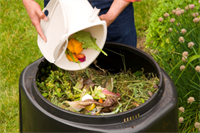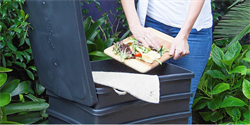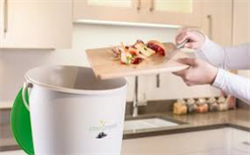Composting Organics
Jump to: Compost Bins - Worm Farms - Bokashi Bins
Around 40% of our household waste is organic and can be diverted from landfill through composting.
Composting converts organic matter like food and garden waste into material that is rich in nutrients and makes an excellent fertiliser or potting mix for your garden.
There are different composting methods available which suit different property types:
- Compost bins are suitable for properties with a yard or garden
- Worm farms are suitable for properties with balconies or shaded areas
- Bokashi bins are suitable for indoor environments.
Composting principles
The principles of ADAM — Aliveness, Diversity, Air and Moisture — will help you create a healthy home composting system.
A is for Aliveness
Micro-organisms such as microbes, bacteria and worms are needed to break down your organic matter and turn it into compost
D is for Diversity
A healthy compost pile needs a diverse range of materials to make a balanced and nutrient rich compost
A is for Air
Good aeration is important in helping waste break down and keeps the compost pile from smelling
M is for Moisture
Compost needs moisture to help materials break down and should ideally be as wet as a damp sponge.
Troubleshooting
Not everything goes to plan all of the time! Here are some solutions to common problems that can occur.
| Problem |
Solution |
| Compost is too dry |
Add water and wet organic materials |
| Compost is too wet |
Add dry organic materials and mix them around |
| Materials are not breaking down |
Cut materials into smaller pieces |
| Foul odours |
Turn the compost using an aerator |
| Flies or vermin |
Reduce food waste and add compost conditioner |
Compost Bins
Setting up your compost bin
- Put your compost bin directly on the soil in an area of your yard that’s easy to access, well-drained and has some shade
- Add a layer of twigs on the base, followed by alternating layers of the below nitrogen-rich and carbon-rich materials. The smaller the pieces, the better, as they will break down quicker.
- Nitrogen-rich materials include fruit and vegetable scraps, tea leaves, teabags, coffee grounds, grass clippings and garden trimmings. These are often referred to as ‘green’ or ‘wet’ ingredients.
- Carbon-rich materials include dried leaves, twigs, straw, newspaper, shredded paper, eggshells and egg cartons.
- These are often referred to as ’brown’ or ‘dry’ ingredients.
- Place a compost blanket or hessian sack on top of the pile to retain the heat and put the lid on.
Maintaining your compost bin
- Continue to add a mix of approximately 50:50 nitrogen-rich and carbon-rich materials each week
- Sprinkle a teaspoon of compost conditioner when you add food
- Turn your compost using an aerator once a week to keep it aerated and healthy
- Keep your compost damp at all times, adding water when necessary.
Using your compost
- It can take anywhere from six weeks to six months for your compost to break down enough to use it, depending on what materials you put in, the temperature and how often you tend to it. Once it’s ready, your compost will look like a rich dark brown clumpy soil and smell earthy.
- Add your finished compost as fertiliser on garden beds, as topsoil on lawns, or as potting mix in pots.
Worm Farms
Setting up your worm farm
- Put your worm farm somewhere in a sheltered, shady and cool position that’s easy to access.
- Assemble your worm farm and bedding block as per the instructions that come with the worm farm. Spread the worms on top of the bedding, place the worm blanket on top and close the lid.
- After a couple of days, add a 2cm layer of the following items to the top tray below the worm blanket:
- Fruit and vegetable scraps (no citrus, onions, garlic or chilli)
- Coffee grounds and tea leaves/bags
- Newspaper and shredded paper
- Crushed eggshells.
Maintaining your worm farm
- Add more food when the worms have finished the previous scraps, ensure they are in small pieces
- Sprinkle a teaspoon of worm conditioner once a week when you are feeding your worms
- Add the second tray once the top tray is full. This will take around three to six months to fill up
- Once both trays are full, remove the lower working tray and remove the castings, then rotate the trays so this is now the top working tray. Continue feeding in the new top tray
- Flush the worm farm weekly with five litres of water and open the tap to drain and collect the liquid.
Using your worm castings and liquid
- The castings can be used on your garden or mixed with regular soil as potting mix.
- The worm liquid can be diluted with water (one part worm liquid to ten parts water) and used as a fertiliser for your garden.
Bokashi Bins
What is Bokashi?
- Bokashi is an indoor composting system that uses a liquid spray or powder to help ferment and break down food waste quickly. The fermented waste material produced then needs to be buried in a garden or compost bin to complete the decomposition process.
- You can put all types of food waste in a Bokashi bin, including cooked and raw food, fruit and vegetable scraps, coffee, tea, meat, fish, dairy, onion and garlic. Cut them into small pieces and avoid bones.
How to use your Bokashi bin
- Add your food scraps to the Bokashi bin, ideally no more than a 3-4cm layer at a time
- Add three to five sprays of liquid Bokashi or one tablespoon of Bokashi powder daily
- Press it all down using a trowel to remove the air
- Close the lid to aid decomposition.
Using your Bokashi liquid and waste material
- Collect the liquid from the tap at the bottom every few days and dilute it in water (two teaspoons of Bokashi liquid per litre of water) to use it as a fertiliser for your garden or pot plants. It also makes a great drain cleaner and can be poured straight down your sink or toilet
- When the Bokashi bin is full, leave it three weeks, then empty the contents into a hole 20-30cm deep in the garden or a compost bin and cover it up again. It will break down into organic matter that will improve the condition of your soil and help your plants grow. Wash out your Bokashi bin afterwards.
- Don’t have a garden? Bury the Bokashi waste in your pot plants. You could also ask your family and friends if you can add your Bokashi waste to their compost or garden.